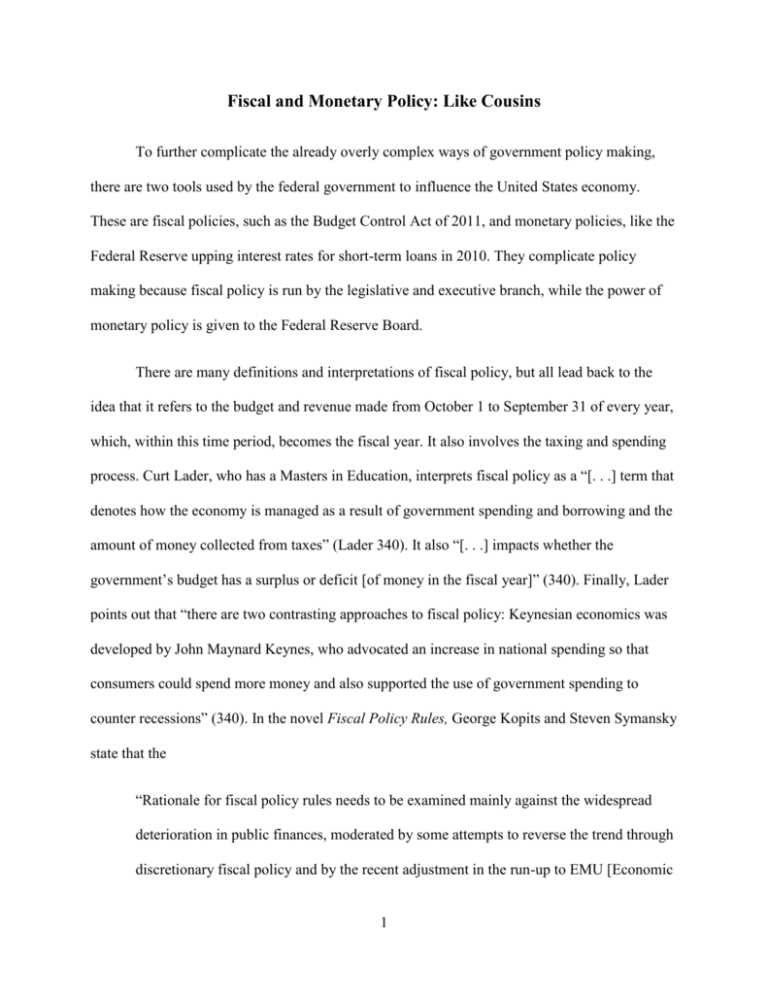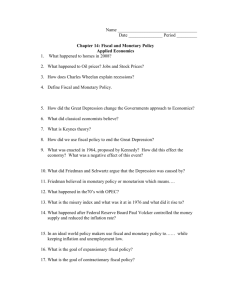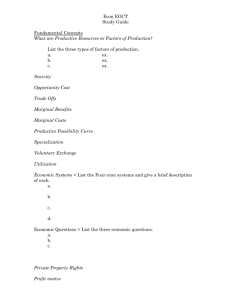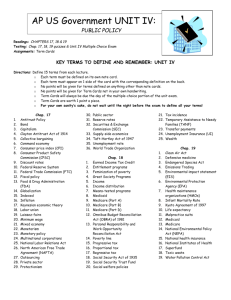A way that the executive branch influences fiscal - Course
advertisement

Fiscal and Monetary Policy: Like Cousins To further complicate the already overly complex ways of government policy making, there are two tools used by the federal government to influence the United States economy. These are fiscal policies, such as the Budget Control Act of 2011, and monetary policies, like the Federal Reserve upping interest rates for short-term loans in 2010. They complicate policy making because fiscal policy is run by the legislative and executive branch, while the power of monetary policy is given to the Federal Reserve Board. There are many definitions and interpretations of fiscal policy, but all lead back to the idea that it refers to the budget and revenue made from October 1 to September 31 of every year, which, within this time period, becomes the fiscal year. It also involves the taxing and spending process. Curt Lader, who has a Masters in Education, interprets fiscal policy as a “[. . .] term that denotes how the economy is managed as a result of government spending and borrowing and the amount of money collected from taxes” (Lader 340). It also “[. . .] impacts whether the government’s budget has a surplus or deficit [of money in the fiscal year]” (340). Finally, Lader points out that “there are two contrasting approaches to fiscal policy: Keynesian economics was developed by John Maynard Keynes, who advocated an increase in national spending so that consumers could spend more money and also supported the use of government spending to counter recessions” (340). In the novel Fiscal Policy Rules, George Kopits and Steven Symansky state that the “Rationale for fiscal policy rules needs to be examined mainly against the widespread deterioration in public finances, moderated by some attempts to reverse the trend through discretionary fiscal policy and by the recent adjustment in the run-up to EMU [Economic 1 and Monetary Union] participation in the European Union (EU)” (Kopits, and Symansky 6). This describes the fact that, when creating fiscal policy, it needs to be watched closely for mishaps that would affect other policies. This is why the executive branch and legislative branch influence fiscal policy, because they control regular policy and how it works, they can form fiscal policy around what has been previously made and shape the policy to coincide with others. This is what happened with the current fiscal policy: The Budget Act of 2011, which was signed into law after being passed by the 112th United States Congress on August 2, 2011. It ended the debt-ceiling crisis about a day before it was projected to lead to a non-payment situation (United States). The legislative and executive branch could not come to a conclusion, then they coincided and created the policy to prevent the economy from collapsing and effecting other policies. A way that the executive branch influences fiscal policy is that the president proposes and prepares the federal budget. In Yianos Kontopoulos and Roberto Perotti’s chapter of the book, Fiscal Institutions and Fiscal Performance, describes the significance of the budget, made by the executive branch, in how much each person gains in monetary amounts. This section was taken from an out-of-print volume from the National Bureau of Economic Research: The budget process is the second important determinant [in determining how much each agent in the majority internalizes the costs of the fiscal outcome] because it determines the game played by decision makers. For example, if the finance minister sets the total size of expenditure first, theoretically he or she is in a position to better internalize the costs of aggregate expenditure, and individual policymakers can only bargain over the distribution of this expenditure. At the other extreme, if the budget is just the sum of bids made by individual ministers, without any coordination from the top, the degree of 2 internalization of the costs of expenditure will be at a minimum. (Kontopoulos, and Perotti 82) A significant way that the legislative branch influences fiscal policy is Congress passing the federal budget. As known from previous experience, the size of the legislature affects the decisions made and how fast they are made. Thomas W. Gilligan and John G. Matsusaka from the Marshall School of Business of the University of Southern California give an interesting take on why this affects fiscal policy: There are strong theoretical reasons to expect the size of the legislature to affect fiscal policy, and we found significant supporting evidence in an earlier study of state and local spending during 1960-1990 (Gilligan and Matsusaka, 1995). [. . .] Gerrymandering provides another theoretical reason to expect the size of the legislature to influence fiscal policy. As shown in Gilligan and Matsusaka (1999), the ability to bias policy outcomes by gerrymandering—specifically, the ability to elect a median legislator whose preferences diverge from the median voter—is limited by the number of districts. As the number of seats increases, the ability to bias policy increases. Thus, to the extent that those drawing district lines are seeking to achieve higher (or lower) spending, we expect them to be increasingly successful as the number of districts increases. (Gilligan and Matsusaka 2-4) This means that, when the legislature is larger, the easier it is to bias policy, or affect with your opinion. While fiscal policy is controlled by the legislative and executive branches, monetary policy, on the other hand, is made solely by the Federal Reserve Board. Monetary policy can be defined by many things, Curt Lader infers that it is a “[. . .] term that reflects how a nation’s central bank manages the nation’s money supply either by expanding 3 or contracting the money supply through regulatory policies” (Lader 341). Furthermore, Lader shows what monetary policy is aimed to do by stating “The goal of monetary policy is to influence the economy as reflected on such factors as inflation, economic output, and unemployment” (341). Professor Michael Woodford, in his novel Interest and prices: foundations of a theory of monetary policy, explains the current way that monetary policy is interpreted and used as: “A notable feature of the new rule-based approaches to monetary policy is the increased emphasis given to a particular policy objective: maintaining a low and stable rate of inflation” (Woodford 4). John T. Woolley, who is a professor, and holds a chair, in the University of California’s Political Science department, explains monetary policy by saying: “If monetary politics is not about whether monetary policy counts, what is it about? Typically, it is about maintaining large-scale economic balances – that is, keeping interest rates, exchange rates, bank credit, and so on in some appropriate relationship to inflation, employment, economic growth, and international payments flows” (Woolley 3). Which means the same as the other definitions, concluding that monetary policy means regulating the money supply, controlling inflation and deflation, adjusting interest rates to regulate the economy, adjusting bank reserve requirements, and the cost of money. “The Federal Reserve is the central bank of the United States and uses its open-market meetings to determine monetary policy” (Lader 341), also, the Federal Reserve, established by Congress in 1913, is the only organization in charge of monetary policy. A few reasons of many why the Federal Reserve Board is given independence in establishing monetary policy are that it, firstly, removes politics from monetary policy decision making. This is important because 4 Congress and the President remove any responsibility for difficult decisions from their shoulders. Also, the Federal Reserve Board relies on expertise when making decisions so that the citizens know that the important decisions were handled with the best of care. As John T. Woolley questions then goes on to answer in his book in his book Monetary Politics: The Federal Reserve and the Politics of Monetary Policy, “A sufficiently restrictive monetary policy can quite reliably produce a depression and even an economic collapse; too little money is dangerous, just as is too much. The trick, of course, is knowing what ‘just right’ is and knowing how to achieve it” (Woolley 4). He is explaining here why the Federal Reserve Board is in charge of monetary policy, because they know what “just right” (4) means and by exactly what means to achieve it. Woolley goes on to explain why “It is not simply a technical issue” (4) and why the policy makers are not in charge of monetary policy, because “policy makers have to choose whether to err on the side of more or less restrictive policy” (4), “there is a commonsense notion that pain caused by policy can be eased by reversing policy” (4), “we often fight one problem at a time, and policy makers have to decide when to stop fighting one problem and shift their attention to another” (4), “And it is not simply a technical issue because the short-run nature of many political pressures prompts policy makers to subordinate consideration of long-run technical constraints” (4). This all means that the politicians have too much on their plate to worry about monetary policy and its effects on the country. A recent example of monetary policy is when, in February 2010, the Federal Reserve raised the interest rates for short-term loans to banks. It did this to show that “[. . .] the era of extraordinarily cheap money necessitated by the crisis was drawing gradually to a close” (Chan) Fiscal and monetary policy are like cousins, they have different parents but are related. The federal government uses both of these to influence the United States economy. And, 5 although the Federal Reserve Board controls monetary policy and the executive and legislative branches control fiscal policy, they coincide and, thankfully, do not contradict each other. 6 Works Cited Chan, Sewell. "In Surprise Move, Fed Signals Pivot to Normal Policy." New York Times 19 Feb. 2010. NY Times. The New York Times Company, 18 Feb. 2010. Web. 23 Mar. 2012. Kontopoulos, Yianos, and Roberto Perotti. "Government Fragmentation and Fiscal Policy Outcomes: Evidence from OECD Countries." Fiscal Institutions and Fiscal Performance. Ed. James M. Poterba and Jürgen Von Hagen. Chicago: University of Chicago, 1990. 82. The National Bureau of Economic Research. Web. 21 Mar. 2012. Kopits, George, and Steven A. Symansky. "Rationale and Institutions." Fiscal Policy Rules. Washington, DC: International Monetary Fund, 1998. 6. Google Books. International Monetary Fund. Web. 20 Mar. 2012. Lader, Curt. Barron's AP U.S. Government and Politics Flash Cards. 2008. Flash Cards. Thomas W. Gilligan, Thomas W., and John G. Matsusaka. Fiscal Policy, Legislature Size, and Political Parties: Evidence from State and Local Governments in the First Half of the 20th Century. University of Southern California. University of Southern California. Web. 19 Mar. 2012. United States. Printing Office. Public Law 112 - 25 - Budget Control Act of 2011. U.S Government Printing Office. Web. 24 Mar. 2012. Woolley, John T. "What Is at Stake?" Monetary Politics: The Federal Reserve and the Politics of Monetary Policy. Cambridge [Cambridgeshire: Cambridge UP, 1984. 3-4. Google Books. Cambridge University Press. Web. 19 Mar. 2012. 7









